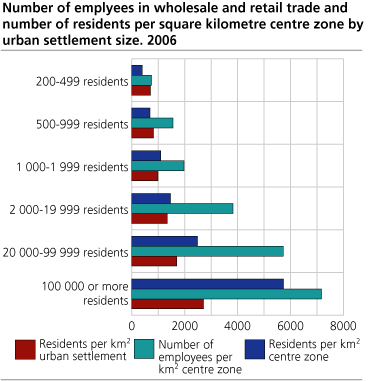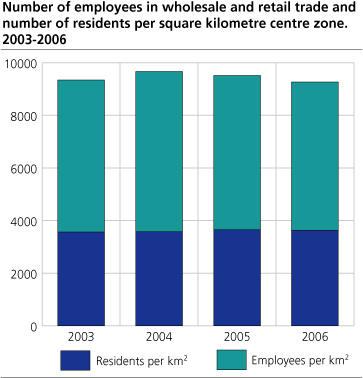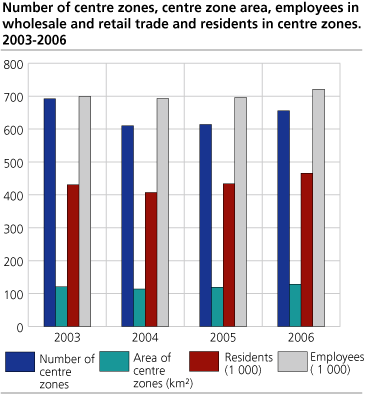Content
Published:
This is an archived release.
Land use intensity unchanged
There has been a slight increase in the number of centre zone employees and residents the last two years, although an accompanying area growth means the density is unchanged. The largest urban settlements have the highest density of employees as well as residents.
According to the white paper no 23 (2001-2002) to The Parliament: “Improving urban environment”, the government wants to develop cities and towns with efficient and environmentally friendly transport, which contribute to health-enhancing transportation choices, consumption patterns and lifestyles. This requires a denser urban organisation. New figures from Statistics Norway show that more people in urban areas not necessarily mean higher density in the same areas.
High density of residents
Concentrated development of cities and towns will reduce the growth in transportation needs for both businesses and the populace, and it will improve accessibility for people that do not have a private car. A concentrated city-structure also contributes to reducing the strain on valuable forests, outdoor recreation areas, farmland, cultural environments and biological diversity around cities.
In the central parts of urban settlements development should primarily occur through new and improved uses of poorly utilised land and existing structures within the building zone, rather than development of new land and further urban sprawl.
High density of residents, is an indicator for effective land use utilisation as well as less energy demanding transportation. High density of residents can on the other hand indicate poor dwelling conditions, scarcity and pressure on green areas.
Around 10 per cent of the population lives in centre zones, which is a slight increase from previous years. On average there are 3 600 residents per square kilometre in centre zones compared to 3 600 per square kilometre in urban settlements. Centre zone residents then live twice as densely as the average urban settlement residents. There has been little variation in the number of employees per square kilometre over the years, however a slight decrease can be observed for the last two years.
The largest urban settlements have the highest resident density. The density in centre zones decrease by urban settlement size. The decrease by urban settlement size is larger in the centre zones than in the urban settlements. The density of employees is also highest in the largest urban settlements, where the density of employees is close to the density of residents. In urban settlements with less than 100 000 residents there is twice the density of employees as the density of residents.
Weak increase in number of employees and residents
There has been a slight increase in the number of employees, residents and area of centre zones during the last two years. Of all the centre zones, most are located in urban settlements with at least 20 000 residents and most of the increase has also taken place in these largest urban settlements.
Results from the country-wide mapping of centre zones reveal that 648 of the 656 centre zones are concentrated in just 238 of the 905 urban settlements as of January 1. 2006. The total centre zone area comprises 128.15 square kilometres, or just below 6 per cent of all area covered by urban settlements. In the other 667 urban settlements, is has not been possible to identify centre zones by the definition applied. 8 centre zones are located outside of urban settlements.
Even though the number of centre zones has gone up and down since the year 2000, the area and population has been more or less the same. This is caused by the fluctuation of minor centre zones, which do not affect the total area or number of inhabitants.
|
Important terms
Statistics Norway definition:
1. A centre zone consists of one or more centre kernels and a 100 metre zone around them. 2. A centre kernel is an area with more than 3 different main types of economic activity with centre functions. In addition to detail trade, governmental administration or health and social services or social and personal service must be present. The distance among enterprises must not be more than 50 meters. |
Tables:
Additional information
This statistics monitor the development in centre zones in relation to residents, employees and density. Based on automatic delimitation of the centre zones.
Contact
-
Erik Engelien
E-mail: erik.engelien@ssb.no
tel.: (+47) 91 12 55 45
-
Jørn Kristian Undelstvedt
E-mail: jorn.kristian.undelstvedt@ssb.no
tel.: (+47) 94 50 68 64



